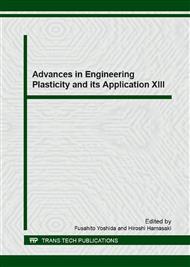p.529
p.537
p.542
p.548
p.554
p.560
p.566
p.572
p.578
The Numerical Simulation of Multi-Stage Sheet Metal Forming Based on Modified Yoshida-Uemori Hardening Model
Abstract:
Bauschinger effect is significant for metal forming, particularly for aluminum. A material constitutive model especially for multi-stage sheet metal forming is presented in this paper, which is improved based on Yoshida-Uemori(Y-U) model assumes that there exists different coefficient on equivalent back stress and boundary surface between stages. The prediction of this model is validated through real tension and compression test. Compared to other hardening rules, it can be shown that a more accurate result can be predicted by this model. This model is also successfully applied to be used in the numerical simulation of a multi-stage manufacturing process of an A-pillar, the experimental result demonstrates the advantage of this model in springback analysis in multi-stage simulation over other constitutive model.
Info:
Periodical:
Pages:
554-559
Citation:
Online since:
December 2016
Authors:
Price:
Сopyright:
© 2017 Trans Tech Publications Ltd. All Rights Reserved
Share:
Citation:


